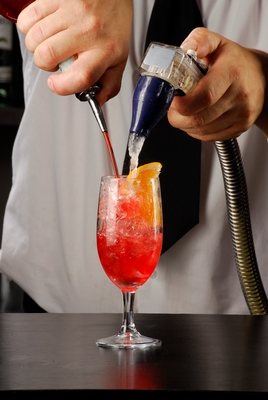How to get new customers through the door and keep them coming back for more
09 Apr, 2014 | Tags: bar scheduling software, Employee morale, employee satisfaction, Employee Schedule, Employee schedule calendar, employee schedule template, Employee Schedules, Employee Scheduling, employee scheduling program, Employee Scheduling Software, New customers, online employee scheduling, restaurant schedules, restaurant scheduling software, Scheduling, Staff Scheduling, Staff Scheduling Software, Workforce Scheduling
Getting new customers through the door is a large feat in itself, but keeping them can be just as challenging. There are many factors that play into the customer experience. We have put together the list of some simple and budget friendly ways to get new customers, and a list of reasons that weighs heavily on their decision to come back.
How do I attract new customers?
Getting new customers is the goal of all businesses; you cannot grow by simply maintaining your current customers, you need new customers. Trying a new restaurant is a big gamble for most people in today’s market, as they are very selective on where they spend their hard earned money.
Standout
You need to be known for something, it can be type/ethnicity of food you offer, special promotions or signature dishes.
Be social
If people don’t know that you are out there, how are they ever going to walk in the door? Social Media is huge in today’s culture, not only can you share images, articles and experiences, but now with “check-ins” friends of your patrons can see that they came to your establishment.
Offer deals
A great way to get new customers to try your bar or restaurants is to offer special deals for new customers, such as a free appetizer or shared dessert.
How do I keep customers coming back?
Now that you have new customers coming in the door, let’s look at the flip side of keeping them coming back for more. There are many reason that you could experience slow nights (bad economy, it’s a week night or that there are no special events or holidays) that are out of your control. Here are the top 3 reasons within your control that make customers decide not to return to your bar or restaurant.
Current Menu
Regularly check your menu to ensure that your pricing is aligned with your target demographic and that you are mixing in enough seasonal/trendy offerings with your signature dishes to keep customers interested and coming back for more.
Loyalty Programs
Loyalty programs can be as simple as deals based on the amount of money spent during each visit and/or the number of visits, and offer discounts on future purchases.
Welcoming Atmosphere
You guests have come to you not only for food and drink, but an enjoyable time with friends and family. Some of the top areas of importance include clean floors/tables/bar, clean bathrooms and the service that they receive.
How do I ensure employee satisfaction?
To ensure your customers will have a great experience, you must have a happy staff providing high quality service. The number one reason for employee dissatisfaction stems from scheduling. Scheduling includes ensuring that you have the right number of staff on for your customer level and ensuring that you fairly allot time-off and/or overtime shifts. What Time Do I Work.com offers easy-to-use and affordable online scheduling software designed to make scheduling a staff of any size a breeze with features like automatic staff communication about schedules, the ability to track and store employee time-off requests and scheduling conflicts and overtime alerts. Try What Time Do I Work.com for yourself today and get the first 30 days free.
What is a Signature Cocktail (and why you need them too!)
17 Mar, 2014 | Tags: bar scheduling software, Employee Schedule, Employee schedule calendar, employee schedule template, Employee Schedules, Employee Scheduling, employee scheduling program, Employee Scheduling Software, online employee scheduling software, signature cocktail, Staff Scheduling, Staff Scheduling Software, workforce schedule
According to Wikipedia a Signature Cocktail “is any unique or original drink that expresses the nature of the person or establishment creating it.” Signature cocktails typically incorporate local ingredients and culture; match a theme or color for the establishment; and represents the customs of the local area. A signature cocktail is a distinction from your competitors and gives you an opportunity to enhance the experience of your customers.
Before you start creating signature cocktails you should look at current trends. The new fad is all about juicing, try incorporating more juices into your signature drink to reach this portion of the population. We are also seeing a lot of bars and restaurants offering bacon in the drinks, adding a new flavor. Try experimenting with these trends to offer drinks that appeal to a large audience.
When you go to start making your signature cocktail you will find that there are many ways to make a drink your own; you can even make your own liqueur by infusing fruits, herbs, or edible flowers into your favorite liquor to create a truly original drink. You should try combining complementary flavors like sweet & sour or sweet and salty. Another great way to create a signature drink is to substitute some ingredients and play with the recipe of other drinks, inevitably your drinks will come down to trial and error, but these steps will help until you find the perfect balance.
To find the extra time to experiment with your own unique cocktail, you can use online employee scheduling software. What Time Do I Work.com has helped many clients cut the time spent creating and updating schedules by more than 50%. This affordable scheduling software will make your scheduling a breeze and help you uncover unnecessary labors costs that you might not be aware of. With automated labor cost calculations, scheduling conflicts warnings and overtime shift notifications, you can significantly cut your labor costs. Try it today and get your first 30 days free with our no obligation free trial.
The History of Scheduling & 5 Scheduling Myths Busted
10 Mar, 2014 | Tags: bar scheduling software, Employee Schedule, Employee schedule calendar, employee schedule template, Employee Scheduling, employee scheduling programs, Employee Scheduling Software, hospital scheduling software, hotel scheduling software, online employee scheduling software, restaurant schedules, Restaurant scheduling s oftware, Staff Scheduling, Staff Scheduling Software, workforce schedule
Scheduling began its origins in ancient times when shift work made its first appearance with the need for kingdoms and military watchmen to stand vigilant 24 hours a day. Over time shift working began to growthrough different industries, and in the late 1800s starting with the invention of the light bulb and expansion of electricity, it was now possible to have employees working even through the darkest nights.
With the rising costs of fixed assets and the increased time required to start up machinery, it became more financially sound for certain industries, such as steel mills, iron foundries and textile mills, to have non-stop production. At this time the first traditional models of workforce scheduling appeared, splitting up workers into rotating day and night shift groups. The first schedules were very simple and consisted of working 12 hour shifts with half the staff scheduled to work at night, and the remaining staff scheduled to work during the day. This workforce scheduling would continue for 13 straight days per employee with 1 day off before being scheduled for the opposite shift; however this resulted in a high level of work related accidents and injuries.
In 1866 the first industry unions began pressuring businesses and the government to limit the number of work hours to 8 per day, however at this time the idea was met with a tremendous amount of resistance. It wasn’t until 1933 that congress passed their first labor act, “National Industrial Recovery Act” detailing minimum wage, maximum work hours and collective bargaining. This act was later repealed and replaced with the “Wagner Act” that went much further by also defining rules and regulations for part-time workers and overtime requirements.
In the 1960s 12 hour shifts again became popular to employees looking to complete their work during fewer days, increasing time with family and friends. This continues today, but has become more complicated with employers offering different lengths of shifts, and then scheduling their workforce to overlap for portions of the shifts. Due to this paradigm shift, scheduling software like What Time Do I Work.com has become a required tool to ensure that businesses of all industries are adequately staffed, while taking less time to create the schedule. This is the future of scheduling!
Myths of Scheduling Software:
Employee scheduling software is expensive
What Time Do I Work.com is affordably priced and offers special pricing based on company size. On average users spend about 75% less time creating and dealing with their weekly schedules, and end up saving themselves and their employees many wasted hours each week.. What Time Do I Work.com employee scheduling software saves time throughout all aspects of scheduling, with unique features such as our automatic conflict alerts and approved time-off requests that are auto populated on schedule.
Employee scheduling programs are hard to use
Employee scheduling itself can be difficult, but What Time Do I Work.com has specifically designed the software for ease of use. Additionally once you sign up (and anytime you need assistance) there is a wizard to walk you through the features, and to help you add all your information into the program. With our import wizard you can upload all your employee information right to the program, instead of entering the information manually. So set up is a breeze too!
Scheduling software is used by large companies
What Time Do I Work.com scheduling software was designed for all companies, no matter if you have 5 or 500 employees. If you have to create a weekly schedule, then you need scheduling software. Our system has many features that benefit companies of all sizes. The program allows your employees to enter their time off and availability requests directly through the software. This means you no longer need to remember everyone’s requests, they’re saved in the system for you to approve and they are auto populated on the schedule. Once the schedule is created it’s posted online where all employees have access to view it, eliminating countless phone calls asking “What Time Do I Work?”
Scheduling programs require constant and time intensive updates
What Time Do I Work.com provides employee scheduling online supported with secure logins. There are no downloads required, so you can access and create schedules from wherever you are in the world. Also our enhancements to the program are seamlessly added without any disruption of service.
Online employee scheduling programs require long term contracts
What Time Do I Work.com offers monthly pay-as-you-go billing; there are no contracts and no hassles. We‘re so confident that you will love our software that we’re offering the first 30 days free!
Sign up for your no obligation free trial today!
Ten Tips to Success for Restaurateurs
27 Feb, 2014 | Tags: bar scheduling software, Employee Schedule, Employee schedule calendar, employee schedule template, Employee Schedules, Employee Scheduling, online employee scheduling software, Online Restaurant Scheduling Software, restaurant best practices, restaurant schedules, restaurant success, restaurant tips, Staff Scheduling, Staff Scheduling Software, success, Workforce Scheduling
In any direction you look there are hundreds of restaurants ranging from fast food and national chains to your local neighborhood hangout. So why would anyone walk through your door? Simple, they are looking for a solution to a problem and that solution is a good food and great experience. In a world where there are uncountable numbers of options, we have combed the internet for the best tips that will help your restaurant be successful in a few simple steps.
10. Curb Appeal
We have heard more and more about curb appeal in the real estate industry, but the same principles transfer to your businesses. Everyday hundreds of people drive by your establishment and get their first impression of your business before even stepping in the door, so curb appeal holds a lot of power on your success. If you have a Five Star restaurant, your exterior should be equally well maintained.
9. How do you fit in?
Unless you are located on a busy interstate, most of your patrons come from your local area and therefore you should match your pricing and offerings to cater to those types of groups. If you are in a location with mostly families, a trendy or high class restaurant is not going to be a good fit and limit the potential success.
8. Inviting Environment
Once you have your customers through the door, you want to reassure them that they came to the right place. The impression you give your customers upon walking through the door is subconsciously telling them about the quality of your food and drinks. Their first impression of your staff is through their host and server, and with great service comes repeat business and higher tips for the staff.
7. Create Signature Cocktails
In this very competitive market you have to stand out from your competitors, by offering a signature drink, dish or dessert you are able to offer what your competitors can’t. These items can bring customers to your restaurant- but while they are getting their favorite drink that only you offer, they are also ordering appetizers, dinner and possibly dessert.
6. Advert Your Eyes Here
We all know that advertising is important to every business, but for restaurants these are more critical. The advertising efforts and promotions for restaurants do not have to be significant portions of a monthly budget. Here’s a few of the best ideas (although the list is endless):
- Happy Hour drinks and special pricing
- Two for One Specials
- Buy two meals get a free desert
- Family Discounts
- Early Bird Specials
5. Defrost your Capital
While it may seem like a good idea to buy your ingredients in bulk and store the extra in freezers, you are actually losing a large chunk of money that you may not see for weeks or even months. Not only do customers value fresh ingredients and are willing to pay a little extra for them, with fresh ingredients you are also not holding such a large inventory in the expectation of future sales.
4. 86 the 86’s with Inventory controls
A fast way to lose money in a restaurant is through missing inventory, and there are many different causes. For inventory control you need to keep track of your inventory, and calculate weekly because inventory is affected by many different factors such as portion sizes, waste, etc. Knowing what you have in inventory will help your purchasing decisions and needs. On top of this knowing what you are losing based on the above factors can help you see holes in your processes that could make you more profitable.
3. The Customer is Always Right
Everyone has heard that the customer is always right, and that is true. Why is it true- because the customer is buying your solutions/services based on their feelings and likes. The best way to improve any business is to be open to customer feedback, address it immediately and work to develop a solution to avoid other customers from providing the same feedback if possible.
2. Change with the Seasons
Just like fashions, customer’s tastes change with the seasons and trends. Menus should always be checked and adjusted to fit the current season and updated to include new “trendy” offerings. You don’t want to feature stew and other hot meals in the summer and you want to cater to new trends, such as “juicing” to keep in touch with the interests of your customers.
1. Who’s on First?
Scheduling can be one of the most stressful, yet important things to happen in your business. You need to ensure that your restaurant is adequately staffed for all shifts throughout the day. When doing this by hand you could be scheduling too many employees for a shift and/or too much overtime. What Time Do I Work.com online employee scheduling software was designed by industry experts with many unique features and benefits to make scheduling a breeze. With automatic labor cost calculations available as you create the schedule and overtime alerts, you’re sure to have complete control of your labor costs.
Little Changes that will make a BIG Difference with Customer Service
17 Feb, 2014 | Tags: bar scheduling software, customer experience, customer service, Employee Schedule, Employee schedule calendar, employee schedule template, Employee Schedules, Employee Scheduling, employee scheduling programs, Employee Scheduling Software, hospital scheduling software, hotel scheduling software, Medical Scheduling, Medical Scheduling Software, online employee scheduling software, Online Restaurant Scheduling Software, online staff scheduling, restaurant schedules, restaurant scheduling software, restaurant staff scheduling, Shift Scheduling, Staff Scheduling, Staff Scheduling Software, Whattimedoiwork.com, Workforce Scheduling
In the food service, bar and nightclub industries you are selling more than just food and drinks to your patrons. While quality food and drinks are important, there are probably many other similar restaurants, bars or nightclubs in your area that offer similar selections. What you are truly selling is a solution to a problem and what distinguishes you from your competitors is the customer experience you provide. We have searched far and wide to provide you with the best advice for improving customer experiences.
The first place to start is to challenge your staff to provide more than expected for every customer during their scheduled shifts. Servers should ensure that customers’ drinks never get below 1/3 full, offer extra bread for extended waits, and remember to always maintain eye contact and be personable when taking orders and interacting with customers.
You can really go above and beyond if you’re near a theater, sports area, etc., by asking your customers if they are in a rush and try to accommodate their limited time needs. Help your customers during the ordering process by pointing out deals on items that they are ordering. You can offer additional perks for your customers, such as tasting different foods and wines before ordering. You might make a little less on this sale, but they will be sure to return. And if you have an unhappy customer, thank them for their honestly (they told you instead of someone else) and look for a simple way to rectify the situation.
Improving the customer experience does not rely solely on your staff. As a manager/owner there are ways you need to train and prepare your staff for success. Train your servers on how to handle different customers (large groups, first time visitors, families) so that they can provide a superior level of service to every customer. Another great tip is to fully train your staff on your menu, ensuring they can answer any questions. Ensure that you fully train your entire staff on your policies and procedures, as well as when to escalate situations to the manager.
Here are some of the items that each of your servers should know off the top of their head:
- What foods are spicy
- Ingredients in each dish
- Items for special dietary requirements
- Tasted all items including specials
The final crucial piece of the puzzle is all about scheduling. There is a tight line to walk to ensure that you have adequate staffing for all shifts (over- and under- staffing not only impacts your bottom line, but can seriously impact the customer experience). What Time Do I Work.com has reports and features that can help you determine the ideal coverage for each of your scheduled shifts. Check back here in our next edition to learn more about how What Time Do I Work.com helps to determine your staff requirements for each shift. Can’t wait? Click Here to try it out for yourself for 30 days in our no obligation free trial.





